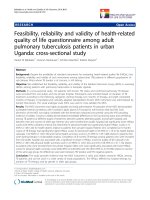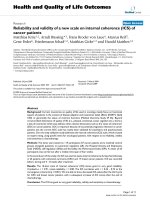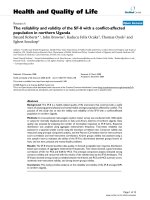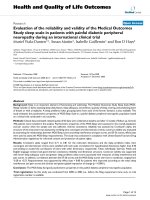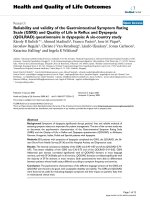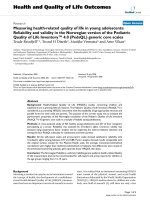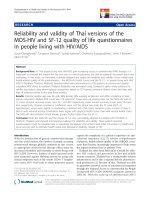Reliability and validity of the vietnamese version of the pregnancy physical activity questionnaire (PPAQ)
Bạn đang xem bản rút gọn của tài liệu. Xem và tải ngay bản đầy đủ của tài liệu tại đây (89.56 KB, 9 trang )
SOUTHEAST ASIAN J TROP M ED PUBLIC H EALTH
RELIABILITY AND VALIDITY OF THE VIETNAMESE
VERSION OF THE PREGNANCY PHYSICAL ACTIVITY
QUESTIONNAIRE (PPAQ)
Erika Ota1 , Megumi Haruna1 , Hideki Yanai2,3 , Motoi Suzuki2,3 , Dang Duc Anh 4 ,
Masayo Matsuzaki1 , Le Huu Tho 5 , Koya Ariyoshi, 3 SeonAe Yeo 6 and Sachiyo Murashima1,7
1
Department of Midwifery and Women’s Health, Division of Health Science and Nursing,
Graduate School of Medicine, The University of Tokyo; 2 Center for International Collaborative
Research, Nagasaki University; 3 Institute of Tropical Medicine, Nagasaki University, Japan;
4
National Institute of Hygiene and Epidemiology (NIHE), Ministry of Health, Hanoi; 5 Khanh
Hoa Health Service, Nha Trang, Vietnam; 6 School of Nursing, The University of North Carolina at Chapel Hill, USA; 7 Department of Public Health, Division of Health Sciences and
Nursing, Graduate School of Medicine, The University of Tokyo, Japan
Abstract. This study aimed to translate the Pregnancy Physical Activity Questionnaire (PPAQ)
into Vietnamese, and test its reliability and validity among Vietnamese pregnant women. Intraclass correlation (ICC) and the Bland and Altman method were used to assess the test-retest
reliability of the PPAQ. The Pearson correlations coefficient between the PPAQ measurements
and those obtained from a pedometer that measured step counts (10-day averages) were
used to determine the validity of the questionnaire. The PPAQ was successfully translated
from English into Vietnamese with face validity through a rigorous process of the cross-cultural
validation. For the analysis of reliability, the ICC value was 0.88 (95% CI 0.83-0.94) for total
activity, 0.94 for sedentary, 0.88 for light, 0.90 for moderate, and 0.87 for vigorous activities.
The Bland and Altman analysis showed that the first and second PPAQ total scores did not
significantly differ from zero, and mostly fell within the range of 0 ± 1.96 SD. The analysis of
validity showed that there were moderate correlations with statistically significance (p = 0.02)
between the step counts and PPAQ total. Our study indicates that the Vietnamese PPAQ is
within acceptable reliability and validity.
INTRODUCTION
The maternal mortality ratio (MMR) in Vietnam was 130 per 100,000 live births in 2000
(WHO, 2005). The government aims to reduce
the MMR to 70 per 100,000 live births by
2010. Ac c ord ing to p revious d ata (WHO,
Correspondence: Dr Hideki Yanai, Proffessor of the
Collaborative Study on Emerging and Re-emerging Infectious Diseases in Vietnam Program, National Institute of Hygiene and Epidemiology (NIHE),
1 Yersin Street, Hanoi, Vietnam.
Tel/ Fax: 84-4-972-4493
E-mail:
562
2005), the MMR is mainly affected by intrapartum hemorrhage (41%) and pregnancy-induced hypertension (21.3%). To help antenatal care management of Vietnamese children
and mothers, it is important to obtain scientific information, such as pregnancy-induced
hypertension, gestational diabetes, pre-term
delivery, and low birth weight data to reduce
perinatal risks.
Among pregnant women, physical activity tends to be of lower duration, frequency,
and intensity compared to pre- pregnancy
(Ning et al, 2003; Butte et al, 2004; Lof and
Forsum, 2006). Recent epidemiologic studies
Vol 39 No. 3 May 2008
THE VIETNAMESE VERSION
(Sorensen et al 2003; Dempsey et al, 2004;
Hegaard et al, 2008) have shown that women
who are more active during pregnancy may
have reduced risks of gestational diabetes,
hypertensive disorders, and pre-term birth in
developed countries. However, the amount of
activity required for favorable pregnancy outcomes, remains to be determined in Asian
populations, especially those in developing
countries.
A questionnaire is a feasible tool for assessing physical activity in large populations
for applications including epidemiologic research or public health surveillance. It is easy
to administer, relatively inexpensive, non-invasive, and allows the estimation of activity
intensity.
Most currently available physical activity
questionnaires have been developed and validated in men, and have emphasized participation in moderately and vigorously intensive
sports (Chasan-Taber et al, 2004). However,
most questionnaires fail to include household
or childcare activity, which comprises a substantial portion of physical activity during pregnancy (Schmidt et al, 2002). The resultant
misclassification may provide misleading relationships between physical activity during
pregnancy and maternal and fetal health, limiting the ability to detect important associations with diseases (Dunlop et al, 2001; Moons
et al, 2003; van Baak et al, 2003). Arguably,
the pregnancy physical activity questionnaire
(PPAQ) (Chasan-Taber et al, 2004) is the only
w id ely used t ool for assessing p regnant
women’s physical activity. The PPAQ is an instrument able to measure the duration, frequency, and intensity of the total activity patterns in pregnant women. The PPAQ is short
in length, self-administered, and easily understood by the respondents in a variety of settings, making it useful for epidemiologic research (Chasan-Taber et al, 2004). Because
there is no equivalent questionnaire in Vietnamese, the aim of this study was to transVol 39 No. 3 May 2008
OF THE
PPAQ
late the English version of the PPAQ into Vietnamese, and to examine its reliability and validity in Vietnamese pregnant women.
MATERIALS AND METHODS
Tools
We used the pregnancy physical activity
questionnaire (PPAQ) to measure the duration,
frequency, and intensity of total activity (household/caregiving, occupational, and sports/exercise) during pregnancy. It is a semi-quantitative questionnaire that asks the respondents
to report on the time spent participating in 32
activities, including household/caregiving (13
activities), occupational (5 activities), sports/
exercise (8 activities), transportation (3 activities), and inactivity (3 activities) (Chasan-Taber
et al, 2004). The respondents were asked to
select a category for each activity to the nearest amount of time spent per day or week.
The duration ranged from 0- to- 6 or more
hours-per-day, and from 0-to-3 or more hoursper-week during the current one month. At the
end of the PPAQ, an open-ended section allowed each respondent to add activities not
already listed but sleeping activity was not included (Chasan-Taber et al, 2004). Self-administration of the PPAQ in Vietnamese takes
approximately 10 minutes.
Translation process
The PPAQ was translated into Vietnamese as follows. First, the English version of the
PPAQ was translated into Vietnamese by a
person whose native language is Vietnamese
and who speaks fluent English as a professional English translator in Vietnam. Second,
a preliminary validation of this translation was
conducted by another Vietnamese English
teacher who is originally from Vietnam, who
speaks fluent English, who has a Master degree in public health from Singapore, and who
had not seen the original English version. The
PPAQ and the back-translation were compared by a public health medical doctor, a
563
SOUTHEAST ASIAN J TROP M ED PUBLIC H EALTH
midwife, a translator in Vietnam, and two midwife researchers (MM, EO) who have Master
degrees in health science in Japan, and one
midwife researcher (MH) who has a Doctoral
degree in health science in Japan. In order to
increase the face validity of the Vietnamese
version of the PPAQ, an experienced supervisor (SY) who is a professor of midwifery and
w omen’s health department in the United
States was consulted. This expert was asked
to assess the content of the questionnaire, and
especially to pay attention to the items and
expressions to see whether they would be
acceptable to and easily understood by a
pregnant woman. A pretest was performed
with five pregnant women. The final version
was modified based on a cross-cultural considerations.
Study subjects
A longitudinal study was conducted at
three commune health centers in Nha Trang
City, which is about 450 km from Ho Chi Minh
City, in central Vietnam, from July to October
2007. Sixty pregnant women were recruited
from their pregnancy check-ups at the commune health centers. Women were considered
ineligible for the validation study if they had
any of the following characteristics: diabetes
requiring insulin administration, hypertension
or heart disease requiring medications, chronic
renal disease, non-singleton pregnancy, under 16 or over 40 years of age. The study protocol was approved by the Institutional Review Board (IRB) of the National Institute of
Hygiene and Epidemiology (NIHE), Ministry of
Health, Vietnam; and by the Graduate School
of Medicine, the University of Tokyo, Japan.
Each participant read and gave written informed consent.
In order to assess the test-retest reliability, the second PPAQ was administered during face-to-face consultations two weeks after the initial one at three commune health
centers. The participants were asked to wear
a digital pedometer (Digiwalker Pedometer
564
SW-200, Yamax Corp, Japan) on a belt at the
waist during active hours in their ordinary daily
activities, except during bathing or swimming
and sleeping. The participants wore the pedometers for two weeks, starting on the day
after their first visit, and they returned them
after 2 weeks when they came back to the
commune centers. Physical activity was evaluated by the average number of steps taken
per day over 10 days (the first two days and
last two days were excluded). Data of physic al ac tivity w ere d oub le entered into the
FoxPro database (Version 9.0, Microsoft, USA,
2007) for further analysis.
Of the 60 participants, 48 were considered to have worn the pedometer continuously
from morning until night for 14 days, 9 forgot
to wear it on the first day, 2 forgot to wear it
the last 2 days, and 1 wore it but forgot to
reset it everyday and could not provide accurate data for the measurement period. A validity study was performed by the 59 participants who wore the pedometer for 10 days,
from the third to the twelfth day.
A pedometer estimates the number of
steps while walking or jogging. The reliability
and validity of the pedometer in counting walking steps have been established in healthy
people (Schneider et al, 2004). We checked
the accuracy of the pedometer for walking
step counts for pregnant women. Pregnant
women wore the pedometers on a belt at the
waist, and walked at their normal pace for 100
steps. The accuracy of the pedometer was
calculated from the walking-step counts obtained from the pedometer, and divided by the
exact number of steps counted for 100 steps.
The mean accuracy of the pedometer was
97.3% (SD = 9.7).
Statistical analysis
The intra-class correlation (ICC) (McGraw
and Wong, 1996) and Bland and Altm an
method (Bland and Altman, 1986) were used
to analyze the test- retest reliability of the
PPAQ. Generally, ICC values above 0.75 indiVol 39 No. 3 May 2008
THE VIETNAMESE VERSION
cate good reliability (Portney et al, 1993). Reliability w as assessed separately for total
PPAQ scores according to intensity, such as
sedentary, light moderate, and vigorous activities; and by types, such as household/
caregiving, occupational, and sports/exercise.
Between and within subject variance components were estimated using log-transformed
activity data assuming a compound symmetric covariance structure. Pearson correlation
coefficients were calculated from the data
between the PPAQ and the pedometer values
to assess the validity of the PPAQ. All statistical analyses were performed using the computer software STATA 10 (Texas, USA, 2007).
P-values < 0.05 were considered statistically
significant.
OF THE
PPAQ
Vietnam and most of them do not use a car,
we added the following to the questionnaire:
‘Riding a bicycle to go places (such as the
bus, work, or school) not for fun or exercise.’
In addition, we replaced the term ‘a car’ with
‘a motorbike,’ for example, ‘driving or riding
in a motorbike or bus’.
Subject characteristics
Table 1 shows the demographics and
characteristics of the participants. The 60 participants had a mean age of 26.8 years (SD =
5.0), and a mean Body Mass Index of 21.3
(SD = 2.5) kg/m 2 . Twenty-three women were
in their first trimester, 21 were in their second
trimester, and 16 were in their third trimester.
The mean and median step counts-per-day
RESULTS
Table 1
Demographic characteristics (N = 60).
Face validity of the Vietnamese version of the
PPAQ
The semantic equivalences of the newly
translated and original PPAQ were achieved
using the back-translation technique. The content equivalence of the questionnaire w as
tested after the translation process by four
experts under clinical supervision (face validity). Overall, during the processes of translation, back-translation, pretest, and face validity assessment of the PPAQ, challenging
considerations were found for the semantic
and content equivalence tasks. The concerns
raised by the semantic differences were all
straightforward because after consideration
and collaboration between the researchers
and the translator, it was found that the questionable concepts were actually identical in
m eaning . Fo r exam p le, t w o it em s w ere
changed in the questionnaire. The question
‘Mowing lawn using a walking mower, raking,
and gardening’ was not commonly used in
Vietnamese culture so we deleted this question. Because many people ride a bicycle or a
motorbike to go to work or other places in
Vol 39 No. 3 May 2008
Mean ± SD
Range
Age (years)
26.8 ± 5.0
17-39
Weight (kg)
50.2 ± 7.0
37-72
Height (cm)
153.6 ± 5.2
143-175
21.3 ± 2.5
16.0-27.1
BMIa (kg/m 2)
Step countsb (per day) 7,358 ± 3,964 303-22,764
Monthly income (US$) 163.2 ± 76.5 66.7-466.7
Education, n (%)
Primary school
8
13.3
Secondary school
30
50.0
High school
15
25.0
Intermediate school
3
5.0
College/university
4
6.7
Trimester, n (%)
First trimester
23
38.3
Second trimester
21
35.0
Third trimester
16
26.7
Occupation, n (%)
Have
35
58.3
Not have
25
41.7
a
BMI: Body mass index
Number of paricipants for step counts were 59,
since 1 pregnant women forgot to reset the pedometer everday.
b
565
SOUTHEAST ASIAN J TROP M ED PUBLIC H EALTH
were 7,357 (SD = 3,964), and 6,369, respectively.
Validity of the Vietnamese version of the PPAQ
To assess the validity of the questionnaire,
total physical activity (light intensity and above)
from the PPAQ was compared to the pedometer values. Overall, the Pearson correlation
Reliability of the Vietnamese version of the
PPAQ
The reliability between the two administrations of the questionnaire was strong (ICC
= 0.88 for total physical activity) (Table 3). The
ICC values for total activity, and subscales
such as intensity and type scores, were all >
0.75, reaching a substantial level. For the
PPAQ total score, the Bland and Altman analysis showed no significant difference between
the first and second PPAQ total scores, with
most of the values falling between 0 ± 1.96
SD (Fig 1).
.5
Total score diffference (MET•h/wk)
Data were obtained from the 60 (100%)
participants who completed the first and second PPAQs. Table 2 shows the median (25 th
and 75 th percentiles) values (MET• h/wk) for the
first and second PPAQs. The first PPAQ median values were comparable to the second
PPAQ median values for total activity (68.1
MET• h/wk vs 54.6 MET• h/wk), and for activity
intensities and types (Table 2).
1.96SDb
.25
0.032 a
0
-1.96SD b
-.25
-.5
1
1.5
2
2.5
Average 1st PPAQ and 2nd PPAQ total score (MET•h/wk)
a
The broken line shows the mean differences in PPAQ
log-transformed total scores.
b
The solid lines show ± 1.96 SD of the PPAQ total
score.
Fig 1–Bland-Altman plots of the first and second
PPAQ log transformed total scores.
Table 2
Median (25 th and 75 th percentile) values (MET• h/ wk) for 1 st and 2 nd Pregnancy Physical
Activity Questionnaires (PPAQs).
1 st PPAQ (MET• h/ wk)
25 th
Summary activity scores
Total activity (light and above)
By intensity
Sedentary (<1.5 METs)
Light (1.5-<3.0 METs)
Moderate activity (3.0-6.0 METs)
Vigorous activity (>6.0 METs)
By type
Household/ caregiving
Occupational activity
Sports/ exercise
Median
2 nd PPAQ (MET• h/ wk)
75 th
25 th
Median
75 th
39.9
71.4
140.7
39.7
55.5
130.2
11.6
35.7
2.4
0.0
26.4
49.7
5.3
0.0
46.8
100.6
36.6
0.0
11.4
35.4
2.1
0.0
24.6
42.7
5.3
0.0
46.8
81.3
35.5
0.0
26.4
0.0
0.8
38.0
5.3
2.4
67.3
67.2
4.2
21.2
0.0
0.8
38.0
0.0
2.4
74.6
66.7
4.2
N =60
566
Vol 39 No. 3 May 2008
THE VIETNAMESE VERSION
Table 3
Interclass correlation coefficients (ICC a)
between two self-administered PPAQs.
ICC (95%CI)
Total activity (light and above)
0.88 (0.83-0.94)
By intensity
Sedentary (<1.5 METs)
0.94 (0.90-0.97)
Light (1.5-<3.0 METs)
0.88 (0.82-0.94)
Moderate activity (3.0-6.0 METs)
0.90 (0.85-0.95)
Vigorous activity (>6.0 METs)
0.87 (0.81-0.93)
By type
Household/caregiving
0.92 (0.88-0.96)
Occupational activity
0.90 (0.85-0.95)
Sports/exercise
0.93 (0.90-0.97)
aICC
were calculated on log-transformed data of 60
participants.
coefficient for measurements between the
PPAQ and pedometer was 0.29 (p = 0.02),
and the correlation between the measurements was moderately significant for total activity (light intensity and above).
DISCUSSION
This study first described the translation
process of the PPAQ from English to Vietnamese. The translation process involved the
methods of translation and back-translation.
The translations were compared by both collaborative parties from Vietnam, US, Japan,
and five experienced researchers. The PPAQ
was successfully translated from English into
Viet nam ese, w it h fac e valid it y ac hieved
through a rigorous process of cross-cultural
validation.
This study also evaluated the reliability
and validity of the physical activity questionnaire in Vietnamese pregnant women. The
PPAQ demonstrated an acceptable reliability
and validity, and provided a useful tool for assessing physical activity in w omen during
pregnancy.
When comparing the median result valVol 39 No. 3 May 2008
OF THE
PPAQ
ues between the Vietnamese version and original English version of the PPAQ (Chasan-Taber
et al, 2004), the total activity (light and above)
of Vietnamese was more than three times
higher than that of the US value (25.2 MET• h/
wk). The activity scores by intensity showed
that the Vietnamese values were higher than
those of the US were. For the sedentary and
light activities, but not the moderate and vigorous activities, the activity scores were higher
than those of the US were. The activity scores
by type showed that the value for household/
caregiving was four times higher in Vietnam
than in the US (38.0 MET• h/wk), that of occupational activity was higher in the US (10.6
MET• h/wk), and that for sport activities was
slightly higher in Vietnam. The results show
that Vietnamese pregnant women do not perform as much moderate and vigorous activity
as US women do. Vietnamese women do seden t ary, lig h t ac t ivit ies , an d h o u s eh o ld /
caregiving activities more than their counterparts in the US do.
An earlier study of the PPAQ among 54
pregnant women assessing the one-week reliability showed that the intra-class correlation
coefficient (ICC) ranged from 0.78 to 0.93 for
all activity indices (Chasan-Taber et al, 2004).
The Vietnamese PPAQ has an excellent absolute agreement with the exact ICC of 0.87
to 0.94. We observed that the measurements
of reliability for the PPAQ in Vietnamese were
higher than previous findings (Chasan-Taber
et al, 2004). This may be because the first and
second PPAQ were conducted differently in
the earlier PPAQ study (the first was done faceto face, and the second was mailed), and faceto face assessments were conducted for both
PPAQs in our study. The results of the present
study indicate the good test-retest reliability
of the PPAQ, for assessing physical activity in
pregnant women.
In order to measure the usual activity
amount during the current one month, we
used estimates of physical activity from a pe567
SOUTHEAST ASIAN J TROP M ED PUBLIC H EALTH
dometer worn for a two-week period. A number of studies (Pols et al, 1998) have been
conducted to determine how many measurement days are needed to estimate reliably
habitual physical activity. In these studies, the
number of days varied between 4 and 12,
depending on the required precision of the
data, the accuracy of the reference method,
and the intra-individual validation in activity.
Two weeks of pedometer use was appropriate and of sufficient duration for our purposes.
We used a pedometer to assess the step
counts as reference equipment for the PPAQ.
The pedometer that we used was one of the
m o s t s u it ab le b ran d s fo r res earc h u s e
(Schneider et al, 2004). The mean accuracy
o f t he p ed o m et er w as hig h and reliab le
(97.3%). The original PPAQ used an actigraph
that could show activity by intensity. The pedometer data did not allow the analysis of
activity by intensity as with an actigraph; it only
reflected total activity. However, the use of
pedometers, combined with a physical activity questionnaire, has been a useful tool to
assess the validity of physical activity (Voorrips
et al, 1991; Sequeira et al, 1995; Ono et al,
2007). The pedometer proved to be useful in
assessing physical activity in a large, free-living population (Sequeira et al, 1995).
Few studies have assessed the validity
of self-administered questionnaires for women
of reproductive age using objective measures
as standards (Ainsworth et al, 1999, 2000;
Chasan-Taber et al, 2004). In the original PPAQ
validation study, the observed overall correlation between the PPAQ and actigraph (average counts/min) was 0.27. Our observations
were comparable to this previous data, with
higher observed correlations for total activity.
The pedometer steps-per-day are only relevant
to total physical activity per day. We could not
assess the validation for physical activity by
intensity and types from the pedometer, but
the original English PPAQ showed validated
physical activities by intensity and types from
568
an actigraph, which were evident correlations
for sedentary (-0.10), light (0.03), moderate
(0.38), vigorous (0.37), household/caregiving
(-0.04), occupational (0.16), and sports/exerc ise ac tivities (0.48) (Chasan- Tab er et al ,
2004).
The validity results are affected by errors
from the pedometer data and PPAQ measurements. For example, because the pedometer
is worn on the hip, errors may result from upper body movements, pushing or carrying a
load, stationary exercise (eg , cycling), weight
lifting, and sedentary activity (Bassett, 2000).
Self-reported physical activity may be affected
by reporting bias, and physical activity questionnaires do not accurately quantify activityrelated energy expenditure (Maddison, 2007).
The inherent difficulties associated with recalling physical activities may limit data for the
estimation of energy expenditure associated
with free living physical activity (Maddison,
2007). Furthermore, errors associated with the
pedometer and the PPAQ are largely independent, that is, our correlation coefficients were
likely to have been underestimated.
In conclusion, the PPAQ in Vietnamese
was within acceptable reliability and validity,
suggesting that the Vietnamese version reflects concepts similar to those of the original
English version. We recommend the use of the
Vietnamese PPAQ for the measurement of
p hysic al ac t ivit y in Viet nam ese p regnant
women.
ACKNOWLEDGEMENTS
This study was part of a research project
funded by grants from the Cooperative Research Grant 2007– 19– A–1, the Institute of
Tropical Medicine, Nagasaki University; the
Program of Founding Research Centers for
Emerging and Reemerging Infectious Diseases, MEXT Japan; and The Ministry of Education, Culture, Sports, Science and Technology (Grant-in-Aid for Scientific Research (B),
Vol 39 No. 3 May 2008
THE VIETNAMESE VERSION
2005-2008, No 17390577). Authors are grateful to the Khanh Hoa Provincial Health Service, especially Dr Truong Tan Minh, Dr Phu
Quoc Viet, Mr Luu Trung Hieu, Ms Trinh Thi
Van Giang, and participating commune health
centers for their assistance during the fieldwork of this study.
REFERENCES
Ainsworth BE, Richardson MT, Jacobs DR, et al.
Accuracy of recall of occupational physical
ac tivity b y q uestionnaire. J Clin Ep id em iol
1999; 52: 219-27.
Ainsworth BE, Sternfeld B, Richardson MT, et al.
Evaluation of the kaiser physical activity survey
in women. M ed Sci Sports Exerc 2000; 32:
1327-38.
Bassett DR. Validity and reliability issues in objective m onitoring of p hysic al ac tivity. Res Q
Exerc Sport 2000; 71 (suppl 2): 30-6.
Bland JM, Altman DG. Statistical methods for assessing agreement between two methods of
clinical measurement. Lancet 1986; 1: 307-10.
Butte N, Wong W, Treuth M, Ellis K, Smith E. Energy
requirements during pregnancy based on total energy expenditure and energy deposition.
Am J Clin Nutr 2004; 79.1078-87.
Chasan-Taber L, Schmidt MD, Roberts DE, Hosmer
D, Markenson G, Freedson PS. Development
and validation of a Pregnancy Physical Activity Questionnaire. Med Sci Sports Exerc 2004;
36: 1750-60.
Dempsey JC, Butler CL, Sorensen TK, et al. A casecontrol study of maternal recreational physical
activity and risk of gestational diabetes mellitus. Diabetes Res Clin Pract 2004; 66: 20315.
OF THE
PPAQ
2008; 198: 180e1-5. [Cited 2008 March 7].
Available from: URL: http:/ / www.ajog.org/ article/ S0002-9378(07)01023-X/ fulltext
Lof M, Forsum E. Activity pattern and energy expenditure due to physical activity before and during pregnancy in healthy Swedish women. Br
J Nutr 2006; 95: 296-302.
Maddison R, Ni Mhurchu C, Jiang Y, et al. International Physical Activity Questionnaire (IPAQ)
and New Zealand Physical Activity Questionnaire (NZPAQ): A doubly labelled water validation. Int J Behav Nutr Phys Act 2007; 4: 62.
[Cited 2008 March 7]. Available from: URL:
http:/ / ijbnpa.org/ content/ 4/ 1/ 62
McGraw KO, Wong SP. Forming inferences about
so m e int ra- c lass c o rrelat io n c o effic ient s.
Psychol Methods 1996; 1: 30-46.
Moons P, Vanrenterghem Y, Van Hooff JP, et al.
Health- related q uality of life and symp tom
experience in tacrolimus-based regimens after renal transplantation: a multicentre study.
Transpl Int 2003; 16: 653-64.
NingY, Williams MA, Dempsey JC, Sorensen TK,
Frederick IO, Luthy DA. Correlates of recreational physical activity in early pregnancy. J
Matern Fetal Neonatal Med 2003; 13: 385-93.
Ono R, Hirata S, Yamada M, Nishiyama T, Kurosaka
M, Tamura Y. Reliab ility and valid ity of the
Baecke physical activity questionnaire in adult
women with hip disorders. BMC Musculoskelet
Disord 2007; 8: 61.
Pols MA, Peeters PH, Kemper HC, Grobbee DE.
Methodological aspects of physical activity assessment in epidemiological studies. Eur J
Epidemiol 1998; 14: 63-70.
Portney LG, Watkins MP. Foundations of clinical research: applications to practice. East Norwalk
CT: Appleton Lange, 1993.
Dunlop DD, Manheim LM, Song J, Chang RW. Arthritis prevalence and activity limitations in
older adults. Arthritis Rheum 2001; 44: 21221.
Sc h m id t M D, Eric k s o n J B , Freed s o n PS,
Markenson G. Physical activity patterns during
pregnancy in a low income racially diverse
population. Am J Epidemiol 2002; 155: S103.
Hegaard HK, Hedegaard M, Damm P, Ottesen B,
Pet ersso n K, Henrik sen TB . Leisure t im e
physical activity is associated with a reduced
risk of preterm delivery. Am J Obstet Gynecol
Schneider PL, Crouter SE, Bassett DR. Pedometer
measures of free-living physical activity: comparison of 13 models. Med Sci Sports Exerc
2004; 36: 331-5.
Vol 39 No. 3 May 2008
569
SOUTHEAST ASIAN J TROP M ED PUBLIC H EALTH
Sequeira MM, Rickenbach M, Wietlisbach V, Tullen
B, Schutz Y. Physical activity assessment using a pedometer and its comparison with a
questionnaire in a large population survey. Am
J Epidemiol 1995; 142: 989-99.
Sorensen TK, Williams MA, Lee IM, Dashow EE, Thompson ML, Luthy DA. Recreational physical
activity during pregnancy and risk of preeclampsia. Hypertension 2003; 41: 1273-80.
van Baak MA, van Mil E, Astrup AV, et al. Leisuretime activity is an important determinant of
570
long- term w eight maintenance after w eight
loss in the Sibutramine Trial on Obesity Reduction and Maintenance (STORM trial). Am J Clin
Nutr 2003; 78: 209-14.
Vo o rrip s L E, Ravelli AC , Do n g elm an s PC ,
Deurenberg P, van Staveren WA. A physical
activity questionnaire for the elderly. Med Sci
Sports Exerc 1991; 23: 974-9.
WHO. Maternal mortality in Viet Nam 2000-2001: an
in-depth analysis of causes and determinants.
Geneva: World Health Organization, 2005.
Vol 39 No. 3 May 2008

